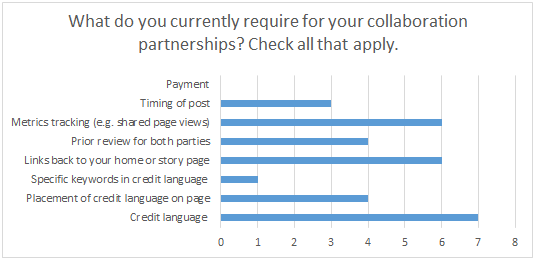
Photo: Pixabay
In an unstable and changing industry, newsroom leaders are always looking for clarity around best practices, norm-setting and how to define emerging terms related to the business of publishing. Throughout our work with the Single Subject News Project at the Shorenstein Center, and particularly at its third cohort convening back in October, the nonprofit news organizations we work with have consistently voiced an appetite for more knowledge and data sharing about newsroom partnerships — since both collaboration and syndication are seen as potentially robust aspects of the nonprofit business model.
To create a baseline for comparison, the Shorenstein Center surveyed eight nonprofit news organizations in November and December about the use of partnerships in their work. Of the sample newsrooms, roughly two-thirds reported a staff size of 10–49 employees, a quarter have 50-plus, and one newsroom employs nine or fewer.
At the highest level, partnership journalism is a broad umbrella term for any instance in which a news organization partners with another organization. There are many types of partnerships, though. Some include sharing data and best practices between news organizations and nonprofit research centers, as with our Single Subject News cohort. Others involve in-kind partnerships to promote event awareness. Of growing interest to nonprofit newsrooms are collaborative co-publishing or syndication partnerships.
“The Marshall Project aspires to partner nearly all of its work with media partners,” said Andrew Bard Epstein, who served as The Marshall Project’s communications and development manager until recently. “We’ve now co-published with over 110 different outlets since our founding four years ago. In many cases, we seek out high-profile, legacy institutions that can draw the largest possible national audience to an investigative feature. In other instances, a regional or daily newspaper may be more strategic to make real impact.”
For the purpose of this field scan, we view news organizations’ publishing partnerships as falling into one of two camps: either a collaboration or a syndication. When surveying our cohort members, we used the term “collaboration” to describe projects between at least two organizations that require, at minimum, some commitment to add value. “Syndication” projects, on the other hand, are those in which organizations offer their content to other news organizations to reprint, as is.
The main aim of partnerships, as defined by our cohort in the survey, is to expand brand awareness. Since most of the news organizations we work with focus on niche subjects such as gun violence or education, and six of the eight qualify as small businesses with 49 or fewer full-time employees, audience reach is key.
“Our site is growing, but modest,” said Gordon Witkin, executive editor at the Center for Public Integrity. “We’re not a daily news site and we have no Kardashians … so we need the eyeballs and the clout that come from a mainstream partner, and our funders want that too.”
By and large, syndication partnerships expand reach while collaborations expand reporting capacity. At the bare minimum, with syndications, a newsroom can reach a larger audience, extending brand awareness and fulfilling their mission of informing the public. At most, with collaborations, partnerships can boost reporting and publishing chops with data, reach and design help.

The survey question above offered three choices: collaboration, syndication or “other.” The “other” category allowed respondents to add their own responses.
Five of the eight newsrooms in our study said that they outright prefer collaborations to syndications. For smaller investigative outlets with content that is expensive to produce, collaborations are a way to extract the most possible output value from the work being done.
“These partnerships are more complicated and challenging — two reporters, two editors, two designers, two web producers, two managing editors, two lawyers, a thousand egos — but we can usually make them work,” said Witkin, of collaborations. “In these situations, we’re often looking for a partner that’s primarily on a different platform from us — NPR, for instance, or the Weather Channel.”
Collaborations often start with a meeting between the news organizations involved, during which time initial reporting and resource commitments are made. Syndications, on the other hand, often begin as email blasts sent directly to other news organizations, asking them to publish existing content as is, with some basic posting requirements.
According to our cohort members, it’s often the leaders at the top of their organization chart who lead partnership meetings — those with titles such as executive editor or founder.
That being said, as partnerships have increased in importance and prominence, we’ve noticed a trend in the number of positions that include the word “partnerships” in job titles, including titles such as “director of media relations and partnerships” and “senior director of partnerships.”
All but one organization we surveyed rated partnerships a five out of five for their importance in the outlet’s long-term strategy. “Partnerships are baked into who we are at The Texas Tribune,” said Natalie Choate, director of media relations and partnerships. “Daily, our distribution partners grab our stories from Austin, DC, El Paso and beyond, freeing [their] newsrooms up to cover topics closer to home.” She continued: “We also recognize and respect our partners’ loyal audiences. We’re grateful to be introduced to them through our media partners and look for opportunities to engage them directly.”
Typical requirements for collaborations and syndications include credit bylines, links back to the news organizations’ home pages, and sharing metrics such as page views. The majority of outlets (at least six of eight) require these components for collaborations. Half (four of eight) require prior review by both partners and specific placement for credit language on a partner’s web page for collaborations.

“We’ve become much more aggressive, in a friendly way, about asserting our requirements and have found most partners to be very amenable,” said Sarah Garland, executive editor of The Hechinger Report. “They will go back and change things if they’ve left something out that we’ve asked for, for example.”
Notably, payment is a bit of a sticky issue. Outlets reported that, by and large, they do not require payment for all content produced for syndications or collaborations, though this may be shifting as partnerships become a more codified practice. For instance, Witkin described a syndication partnership with The Atlantic, in which The Atlantic reprints his organization’s political stories on campaign finance for a per-story payment every few weeks.
Today, it’s common to give away intellectual property for free in exchange for more reach. Think of all that time spent crafting witty tweets! The issue with this, of course, is that “reach” and “impact” remain nebulous terms that are hard to measure (and then monetize).
Lack of payment aside, many of the cohort members highlighted the burden of partnership logistics — specifically citing how often they check to ensure that partner outlets have done what they say they will. In particular, it is difficult to get partner organizations to share metrics such as page views, to embed full partnership language that includes links to newsletter sign-up pages and social media, and to give preferential crediting placement at the top of the page rather than at the bottom.
We asked survey participants for the number of collaborations and syndications they had done to date in 2018, in 2017 and in 2016. It’s difficult to note any clear trends, especially for a group of eight participants. But here is what is clear: All of the news organizations are pursuing partnership growth.
For instance, The War Horse, which is the smallest news organization in the cohort, worked on two collaborations in 2016 and six collaborations in 2017 and 2018, respectively. It did zero syndications in 2016, four in 2017 and 12 in 2018.
Meanwhile, mid-size outlet Chalkbeat worked on two collaborative projects in 2016, and three collaborative projects in 2017 and 2018 each. When it comes to syndication projects, Chalkbeat worked on 30 syndications in 2016, 35 in 2017 and 40 in 2018.
Finally, one of the largest organizations in the cohort, The Texas Tribune, has steadily increased its number of collaborative partnerships, from 18 in 2016, to 23 in 2017, to 35 in 2018.
Open, quick and realistic communication came up consistently as evidence of a healthy partnership. Shared checklists between collaborating organizations can be game changers. Another useful tool highlighted in the survey was the creation of a network of syndication partners, which allows news outlets to reach out to partners all at once, rather than one by one. Avoiding repetition and “recreating the wheel” with each new partner, so to speak, saves time and expands reach.
One newsroom in our survey placed its terms for partnerships on its website, cutting down on the time and effort spent on formal documents like memorandums of understanding (MOU). This could help prevent misunderstanding, especially as most outlets we surveyed said that they only “sometimes” use a MOU with partners, and no single outlet indicated that they always employ one.

The answer options for this survey question were: always, sometimes, never, only when a partner requests it and “other.” The “other” category allowed respondents to add in their own responses.
Here at Shorenstein Center, we’re aiming to use these initial takeaways from our cohort to build out a broader set of best practices. Please reach out to us directly on Medium if you have feedback or ideas, or just generally want to dig deeper into partnerships.
This post first appeared on the Shorenstein Center on Media, Politics and Public Policy’s Medium site and is cross-posted here with permission.
 Caroline Porter is a journalist and media strategist. She wrote this article as part of the Single Subject News Project, a research project of the Shorenstein Center on Media, Politics and Public Policy at the Harvard Kennedy School.
Caroline Porter is a journalist and media strategist. She wrote this article as part of the Single Subject News Project, a research project of the Shorenstein Center on Media, Politics and Public Policy at the Harvard Kennedy School.
